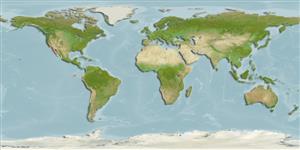分類 / Names
共通名の | 類義語 | Catalog of Fishes(部類, 種) | ITIS | CoL | WoRMS | Cloffa
>
Blenniiformes (Blennies) >
Blenniidae (Combtooth blennies) > Salariinae
Etymology: Hypsoblennius: Greek, hypsi = high + Greek, blennios = mucus (Ref. 45335).
More on author: Jordan.
Environment: milieu / climate zone / depth range / distribution range
生態学
海 底生の; 移住性ではない; 深さの範囲 0 - 18 m (Ref. 2850), usually ? - 5 m (Ref. 56052). Subtropical; 34°N -
Eastern Pacific: Point Conception in California, USA to southern Baja California, Mexico.
サイズ / 重さ / 年齢
Maturity: Lm ? range ? - ? cm
Max length : 17.0 cm TL オス/雌雄の選別がない; (Ref. 2850); 最大記録サイズ: 9 年 (Ref. 56052)
Adults are commonly found in intertidal areas, with homing behavior (Ref. 32612). Also found in subtidal rocky areas. Demersal spawners in nearshore habitats (Ref. 56049). Oviparous. Eggs are demersal and adhesive (Ref. 205), and are attached to the substrate via a filamentous, adhesive pad or pedestal (Ref. 94114). Larvae are planktonic, often found in shallow, coastal waters (Ref. 94114). Eggs are guarded by the male (Ref. 32612). Non-emerging air-breathers (Ref. 31184).
Oviparous, distinct pairing (Ref. 205). Demersal spawners (Ref. 56049).
Eschmeyer, W.N., E.S. Herald and H. Hammann, 1983. A field guide to Pacific coast fishes of North America. Boston (MA, USA): Houghton Mifflin Company. xii+336 p. (Ref. 2850)
Human uses
用具
特記事項
XMLをダウンロードして下さい
インターネットの情報源
Estimates based on models
Preferred temperature (Ref.
123201): 17.1 - 28.8, mean 22.9 °C (based on 204 cells).
Phylogenetic diversity index (Ref.
82804): PD
50 = 0.5000 [Uniqueness, from 0.5 = low to 2.0 = high].
Bayesian length-weight: a=0.00955 (0.00512 - 0.01780), b=3.06 (2.89 - 3.23), in cm total length, based on LWR estimates for this species & (Sub)family-body (Ref.
93245).
栄養段階 (Ref.
69278): 3.1 ±0.40 se; based on food items.
回復力 (Ref.
120179): 手段, 1.4年~4.4年の倍増期間の最小個体群 (tmax=9; Fec = 1,676).
Fishing Vulnerability (Ref.
59153): Low vulnerability (10 of 100).
